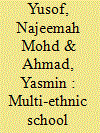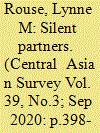| Srl | Item |
| 1 |
ID:
152488


|
|
|
|
|
| Summary/Abstract |
This study aims to identify the challenges and approaches to improve a multicultural competency among teachers in multi-ethnic schools environment based on school leaders’ perspective. Data collection method used in this study is qualitative method. A total of nine school leaders from the states of Kedah, Penang, and Perak were included in the interview session. The results of this study show that the challenges faced by teachers in practicing the multicultural competency are lack of experience toward cultural diversity. A late exposure to cultural diversity makes it difficult for teachers to accept and adapt in a multi-ethnic school environment. The approaches suggested by school leaders to improve the multicultural competency are as follows: (1) Courses on cultural diversity should be organized to enhance the knowledge about cultural diversity; (2) the development of more open and better policy for education system in Malaysia in order to prepare teachers with a higher multicultural competency for teaching students from diverse ethnic and cultural groups; (3) an early exposure to cultural diversity in order to increase the multicultural competency, especially during teaching practicum.
|
|
|
|
|
|
|
|
|
|
|
|
|
|
|
|
| 2 |
ID:
173338


|
|
|
|
|
| Summary/Abstract |
Civilizations are as complex as the human relationships that engendered them, and outlining these relational qualities within open notions of mobility and interaction frames a reconceptualization of Central Asia’s past. Recent Eurasian archaeological research deconstructs deterministic political-economic or hierarchical typologies of civilization and the overly simplified narrative that roots it in urban centres perpetually juxtaposed with nomadic groups. Archaeological evidence from the Oxus Civilization, Central Asia’s earliest complex polity (ca. 2500–1400 BCE), reveals the deep roots of sedentary–mobile interactions. I argue that Oxus–steppe relationships helped maintain the long-term structural cohesion of the Oxus Civilization as a multicultural entity, with implications for subsequent Central Asian polities. As we begin to balance the lopsided conversations about the social formations of Central Asia’s past and present, the silent partnership that characterized the Oxus Civilization is given a voice that forces us to reconsider who, exactly, belongs inside our notions of civilization.
|
|
|
|
|
|
|
|
|
|
|
|
|
|
|
|